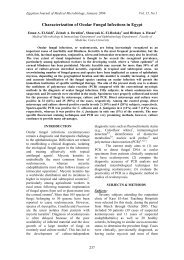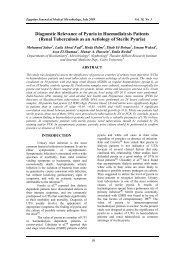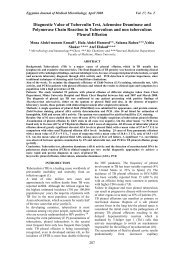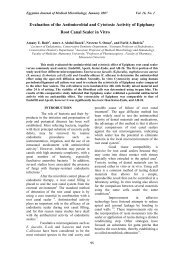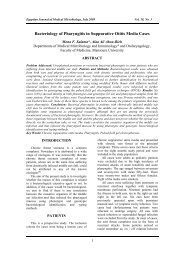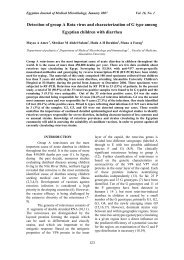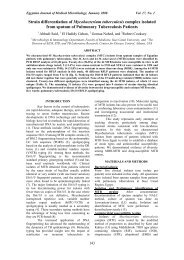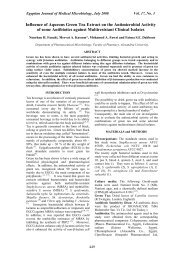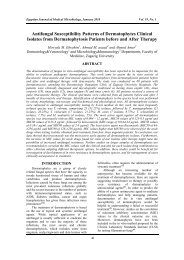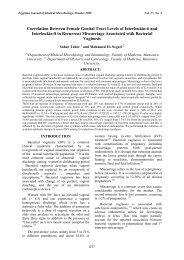Egyptian Journal of Medical Microbiology, January 2007 Vol. 16, No. 1base (Acumedia, Baltimore, Md.)supplemented with 5% human blood (bloodagar) <strong>and</strong> mannitol-salt agar (Oxoid-CM85),were prepared according to the manufacturer'sinstructions.Clinical samples:Suppurative skin lesions of a total of105 pyoderma patients admitted to theoutpatient clinic of the Main UniversityHospital, Alex<strong>and</strong>ria, Egypt, were included inthis study. Swabs were used to collectsuppurative exudates from skin lesions, thenimmediately delivered to the lab forprocessing. Each swab was inoculated <strong>and</strong>spread onto each of the three types of media(BA, MSA <strong>and</strong> CAS). All plates wereaerobically incubated at 37°C, BA for 24 h (10), CAS for 48 h (according to manufacturerinstructions) <strong>and</strong> MSA for 48 h. (10)Identification of S. <strong>aureus</strong>.Golden yellow hemolytic or nonhemolytic colonies on blood agar, yellowmannitol fermenting colonies on MSA <strong>and</strong>mauve colonies on CAS were regarded aspresumptive S. <strong>aureus</strong> <strong>and</strong> were confirmedwith Gram stain reactions, reactions tocatalase (3% [wt/vol] hydrogen peroxide,reactions to slide <strong>and</strong> tube coagulase (rabbitplasma), <strong>and</strong> DNase activity were used foridentification. (10) RESULTSEighty three confirmed strains of S.<strong>aureus</strong> were isolated (from 105 swabs takenfrom suppurative skin lesions) on one or moreagar culture media within 48 h of incubation.A total of 83 strains were isolated onBA after 24 h of incubation.On CSA, 83 strains were recovered asmauve colonies after 24 h <strong>and</strong> no furthergrowth was detected after incubation for 48 h.One of these mauve colony was not provedto be S. <strong>aureus</strong> (false positive). These resultswere associated with sensitivity of 98.79 %<strong>and</strong> a specificity of 95.45 %. (Table 1)As regards MSA, 43 strains wererecovered as yellow colonies after 24 h ofincubation compared with 62 strains afterincubation for 48 h. One yellow colony wasnot proved to be S. <strong>aureus</strong> (false positive).These results were associated with asensitivity of 50.60% <strong>and</strong> 73.49 % after 24<strong>and</strong> 48 h. respectively. (Table 2, 3)Table 1: • <strong>Chromagar</strong> <strong>Staph</strong> <strong>aureus</strong> versus blood agar for detection of S. <strong>aureus</strong> after 24incubation hours.<strong>Blood</strong> agar<strong>Chromagar</strong>totalpositivenegativepositive 82 1 83negative 1 21 22total 83 22 105•After extending incubation to 48 hours mauve color of colonies start to fade away in most ofthe platesSensitivity = T+ve/T+ve+F-ve = 82/82+1= 98.79%Specificity = T-ve / T-ve+F+ve = 21/21+1= 95.45%Table 2: <strong>Mannitol</strong> salt agar versus blood agar for detection of S. <strong>aureus</strong> after 24incubation hours.Bl.agarMSAtotalpositivenegativepositive 42 41 83negative 1 21 22total 43 62 105Sensitivity = 42/42+41 = 50.60%Specificity = 21/21+1= 95.45%64
Egyptian Journal of Medical Microbiology, January 2007 Vol. 16, No. 1Table 3: <strong>Mannitol</strong> salt agar versus blood agar for detection of S. <strong>aureus</strong> after 48incubation hours.<strong>Blood</strong> agarMSAtotalpositivenegativepositive 61 22 83negative 1 21 22total 62 43 105Sensitivity = 61/61+22= 73.49%Specificity = 21/21+1= 95.45%DISCUSSIONIsolation of S. <strong>aureus</strong> is usuallyaccomplished with the use of conventionalmedia such as blood agar. The disadvantageof such media is the need of confirmatorytests to differentiate S. <strong>aureus</strong> from colonieswith identical colony appearance or whenswarming colonies of Proteus cover those ofS. <strong>aureus</strong> on such ordinary media. (2)Performing such tests on all coloniesresembling staphylococci can be timeconsuming<strong>and</strong> labor intensive. (8,11)The use of chromogenic media canpotentially reduce the number of confirmatorytests that are necessary for the detection of S.<strong>aureus</strong>. (4,8)The ideal characteristics of anyc<strong>and</strong>idate chromogenic medium are thedetection of S. <strong>aureus</strong> with high specificity<strong>and</strong> an isolation rate at least comparable toconventional media after 18 to 20 h ofincubation. (4,8)In this study, CAS was highlysensitive (98.79%) for S. <strong>aureus</strong>, where itsucceeded to detect 82 out of the total 83 S.<strong>aureus</strong> strains after 24 h incubation. The samesensitivity (98.5%) was obtained by Carricajoet al., (11) 2001; <strong>and</strong> a near results wereobtained by Gaillot et al., (8) 95.5%, 2000,Perry et al., (4) 96.2% , 2003,<strong>and</strong> D’Souza etal., (12) 69%, 2005. Slightly higher sensitivity(99.5%) was obtained by Flyhart et al. (13) ,2004.In the present study sensitivity ofCAS did not increase with extending theincubation time to 48 h, in the contrary itdecreased, as the mauve color of somecolonies faded away. The same result wasreported by Kluytmans et al., (14) who reportedthat after 48 h the sensitivity of CAS wasslightly lower.In contrast, D’Souza <strong>and</strong> Baron., (12)reported that the sensitivity of CAS afterovernight incubation was 82% <strong>and</strong> increasedto 96% after additional 24 h incubation.<strong>Mannitol</strong>-salt agar (MSA) is one ofthe most widely used selective media forisolation of S. <strong>aureus</strong>. It consists of mannitolto indicate the presence of S. <strong>aureus</strong> <strong>and</strong> avariable concentration of sodium chloride toinhibit the growth of other microorganisms. (15)In the present study MSA had a lowsensitivity of 73.49%, in contrast to thereports of other authors who reported asensitivity reaching up to 96% <strong>and</strong> 97.1%respectively. (12,14)The low sensitivity of MSA in this study wasdue to the high false negative rate which wecould not find an explanation to, except thatthese strains might be inhibited by the highsalt component of this medium. (16)MSA showed a sensitivity of 50.60%after 24 h incubation which markedlyincreased to 73.49% after further 24 h. Thisseems to be consistent with the findings ofD’Souza <strong>and</strong> Baron (12) who mentioned thatthe sensitivity of MSA increased from 71%after 24 h to 96% after extending theincubation to another 24 h.In conclusion, CSA comparedfavorably to conventional media for rapiddetection of S. <strong>aureus</strong> in clinical samples <strong>and</strong>achieved a higher sensitivity <strong>and</strong> specificitythan MSA for the isolation <strong>and</strong> presumptiveidentification of S. <strong>aureus</strong> from suppurativeskin lesions .The use of CSA is much less laborintensive than conventional methods <strong>and</strong>requires fewer reagents for confirmation ofsuspect colonies of S. <strong>aureus</strong>. (12,17)Sometimes, strains which wereconsidered positive after 24 h were negativeafter 48 h. This may be due to variability in65



